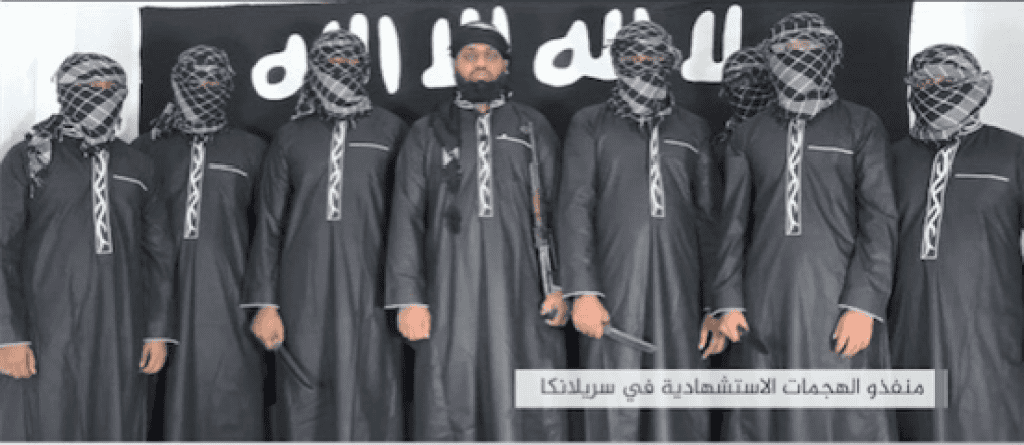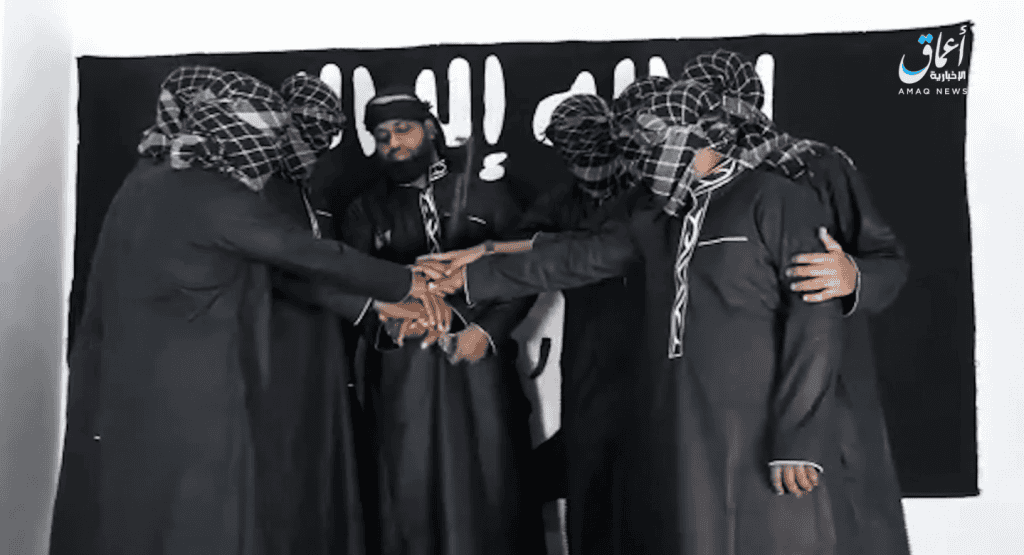
The Islamic State has released three statements and a video claiming responsibility for the bombings in Sri Lanka on Easter Sunday.
The first, a terse statement by Amaq News Agency, offered no details about the operation, saying simply that a security “source” told the group’s media arm that the so-called caliphate’s “fighters” had carried out the attacks.
The Islamic State subsequently released a longer statement, saying that 1,000 people were killed or injured in the orchestrated assault. That statement highlighted the fact that Christians were the intended target, as they are supposedly at war with Abu Bakr al-Baghdadi’s enterprise. The statement also provides the aliases for several of the bombers.
Amaq News then produced a third statement, including a photo of the eight alleged perpetrators standing in front of the flag typically flown by the group. The photo is reproduced above. Only one of the eight is unmasked. That individual, seen in the middle, appears to be Zahran Hashim, a fiery ideologue who spread his hateful message in online videos.
Importantly, Amaq has also posted a video showing the eight perpetrators, led by Hashim, swearing allegiance to Abu Bakr al-Baghdadi before their day of terror.
Amaq has disseminated similar videos after a series of attacks in the past. The footage is intended to underscore the idea that Baghdadi’s loyalists were responsible. As FDD’s Long War Journal has previously assessed, Amaq’s videos demonstrate that there is at least a digital tie between the perpetrators and the Islamic State’s network.

Sri Lankan authorities fingered Hashim as the prime suspect early on, saying that his group, National Thowheeth Jama’ath (or National Thowheed Jamaath, NTJ), likely carried out the assault. In fact, a Sri Lankan police official warned more than a week before the bombings that Hashim and NTJ were planning to assault churches. The tip was informed by “foreign intelligence” sources.
“Foreign intelligence has informed that Mohammed Cassim Mohamed Zaharan alias Zaharan Hashmi [sic] the leader of the National Thowheeth Jama’ath and his followers are planning suicide attacks in this country,” the alert read, according to a translation by the New York Times. “The reports noted that these attacks could target Catholic churches and the Indian High Commission in Colombo.”
The warning either went unheeded, or wasn’t passed along to senior government officials.
Large-scale assault that required significant coordination and planning
Authorities are working to confirm how the plot came together, including what role, if any, was played by the Islamic State’s international terrorist network.
Early on, Sri Lankan authorities pointed to the possibility that there was contact between the plotters and “international” actors, but publicly-available details are sparse. It is certainly possible that there were operational connections between the NTJ and more seasoned operatives. Amaq’s video of Hashim and the others swearing allegiance to Baghdadi makes it likely that there is more to the story.
The bombings in Sri Lanka are one of the worst terrorist attacks since the Sept. 11, 2001, suicide hijackings. The death toll from the large-scale assault has climbed to more than 300 people, as authorities have continued to conduct security sweeps, arresting suspected accomplices and shutting down social media access.
The terrorists clearly planned the attacks well in advance of Sunday, and the explosives they used were highly effective. At least seven suicide bombers hit their targets within a short time of each other — a hallmark of professional jihadist operations. (Amaq’s photo and video show eight jihadists.)
Beginning in the early morning hours of Sunday (Apr. 21), the terrorists struck churches and hotels in and around the capital of Colombo.
The first wave of bombers hit St. Anthony’s Shrine, a Roman Catholic Church, and three hotels. One of these bombings was conducted by a man who stayed at the Cinnamon Grand Hotel the night before and then detonated his explosive device while waiting in line at a breakfast buffet early Sunday, according to Agence France-Presse (AFP).
Two more churches were terrorized in the afternoon. More than 100 people were killed in a suicide bombing at St. Sebastian’s Church, north of Colombo. And more than two dozen additional victims perished in a separate explosion at Zion Church in the city of Batticaloa.
In all, at least nine sites were affected on Sunday, as authorities also defused a large bomb near the Bandaranaike International Airport. Additional bombs were found in the hours that followed.
Retaliation for white supremacist terror attacks in New Zealand?
Sri Lankan officials have said that the bombings were retaliation for the Mar. 15 massacres at two mosques in New Zealand. Those terrorist attacks were conducted by a white supremacist, Brenton Tarrant.
Jihadist groups issued dozens of statements concerning the mass murder in New Zealand. The Islamic State’s spokesman referenced the killings in a rare audio message, arguing that the attack shouldn’t be compared his own group’s supposedly justified violence.
In addition, the 174th issue of the Islamic State’s Al Naba newsletter contained an editorial on the same subject. Al Naba’s editors argued that it was “ignorant” to think that the “Islamic State waits for an attack like this on Muslim’s mosques to incite its soldiers to kill mushrikin [polytheists].” The Islamic State’s “jihad and fight against mushrikin is a duty even if they [Christians or polytheists] were weak and can’t harm Muslims, as long as they lack faith and covenant,” the editorial reads. Al Naba’s editors added that the “war waged by Crusader nations against Muslims did not start when one of their citizens attacked the mosques” in New Zealand. Instead, this religious war “is ongoing, hasn’t stopped and will not stop,” as both New Zealand and Australia are part of “the Crusader military coalition.”
Thus, the Islamic State’s men argued that they didn’t need the terrorist attacks in New Zealand to justify killing Christians. In practice, this is exactly as the group has behaved, as Baghdadi’s representatives have deliberately targeted Christians around the globe.
Zahran Hashim and his men were certainly aware of the killings in New Zealand. The pre-attack warning in Sri Lanka referenced social media accounts controlled by one of Hashim’s followers. The man in charge of these sites was “observed…regularly updating accounts with hate speech again non-Muslims since the March 15, 2019, attacks on a Muslim mosque by a Christian individual in New Zealand,” according to the Times’s translation.
Importantly, however, none of the official statements posted by the Islamic State thus far have portrayed the bombings in Sri Lanka as retaliation for the slayings in New Zealand.








1 Comment
I wonder what comrade Jacinda Ardern’s response to this one will be?